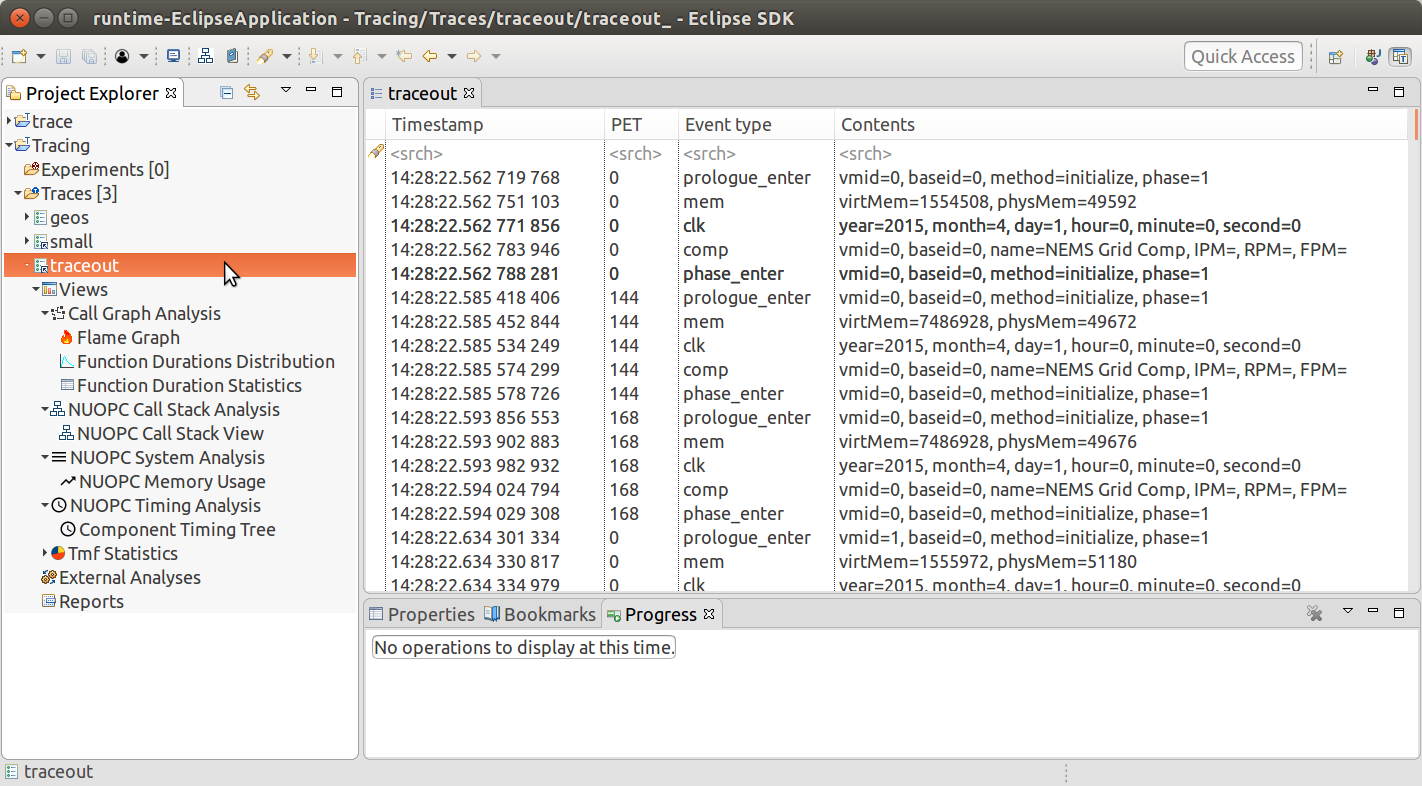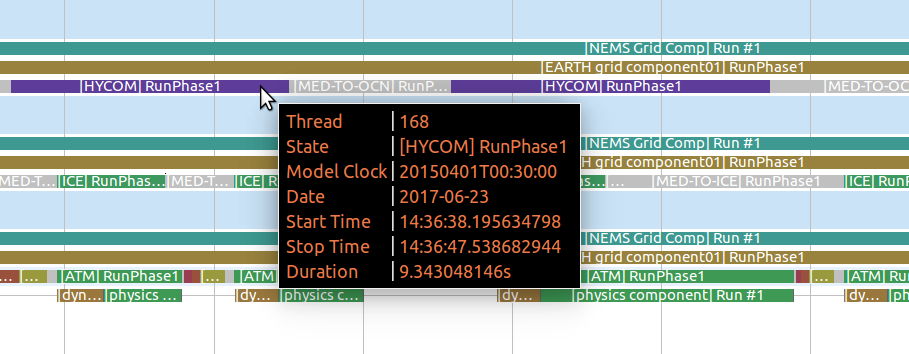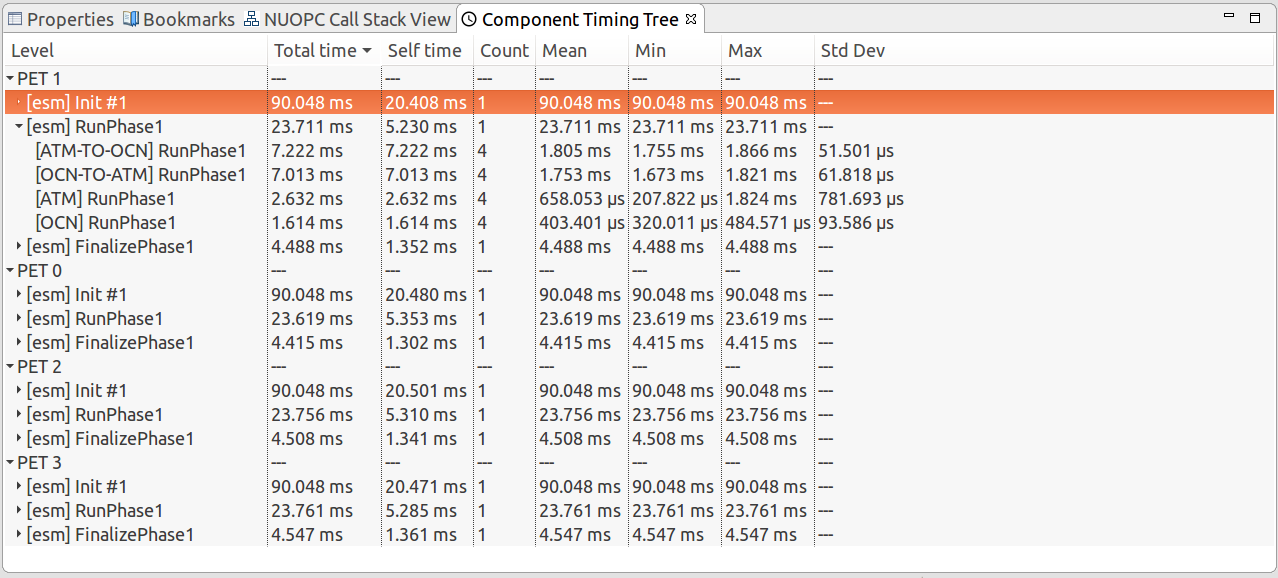3. NUOPC Trace Analysis¶
Important
These features require a new tracing capability available in a development snapshot of ESMF. You must use at least ESMF 7.1.0 beta snapshot 31.
The following command can be used to acquire this development snapshot of ESMF:
git archive –remote=git://git.code.sf.net/p/esmf/esmf –format=tar –prefix=esmf/ ESMF_7_1_0_beta_snapshot_31 | tar xf -
To check out other snapshots, simply replace the ESMF_7_1_0_beta_snapshot_31 with another tag.
Development snapshots are built in the same way as releases. Development snapshots are not formal releases of ESMF and are “use at your own risk.” Efforts are made to ensure that most unit and system tests are passing on typical platforms, but there are no guarantees of the stability of development snapshots.
For more information about development snapshots of ESMF, please email: esmf_support@list.woc.noaa.gov.
This section describes how to use Cupid’s features for analyzing a NUOPC application trace. The analyses show component timings and profiles and is useful for discovering expensive execution phases and determining if there is a load imbalance in the coupled system. The analyses are custom analyses based on the TraceCompass Eclipse plugin. This plugin will automatically install with Cupid.
The overall process requires two steps:
- First, execute a NUOPC application with tracing turned on
- Second, import the trace into Cupid for analysis and visualization
3.1. Generate a Trace of a NUOPC Application¶
First, make sure you compile your application with ESMF version 7.1 beta snapshot 31 or later.
Then, set the following environment variable before the run:
$ export ESMF_RUNTIME_TRACE=ON
This will automatically instrument the components to collect timing and other information to put into the trace.
Though not required, it is highly recommended to set the environment variable ESMF_RUNTIME_TRACE_PETLIST to limit which PETs are traced. This will help to limit the size of the output trace and speed up the analysis. If you do not set this environment variable, all PETs will be traced by default. Each PET should be separated by a space, and you can use the notation “X-Y” to indicate a range of PETs. A good approach is to trace only the root PET of each component in the NUOPC application. Note that PET zero will always be traced, regardless of the ESMF_RUNTIME_TRACE_PETLIST setting.
# turn on tracing for PETs 0, 32, and 64 through 72
$ export ESMF_RUNTIME_TRACE_PETLIST="0 32 64-72"
After setting these environment variables execute the NUOPC application in the way you normally do. The trace itself will be placed into the traceout directory. The directory will contain a metadata file and one file per PET that was traced. For example, if PETs 0, 144, and 168 having tracing enabled, the traceout directory looks like this:
[Rocky.Dunlap@tfe04 traceout]$ ls -la
total 2320
drwx--S--- 2 Rocky.Dunlap stmp 4096 Apr 11 22:20 .
drwxr-sr-x 5 Rocky.Dunlap stmp 73728 Apr 11 23:20 ..
-rw-r----- 1 Rocky.Dunlap stmp 1048576 Apr 11 22:41 esmf_stream_0
-rw-r----- 1 Rocky.Dunlap stmp 229376 Apr 11 22:41 esmf_stream_144
-rw-r----- 1 Rocky.Dunlap stmp 163840 Apr 11 22:41 esmf_stream_168
-rw-r----- 1 Rocky.Dunlap stmp 3370 Apr 11 22:41 metadata
The trace files are in a binary format called Common Trace Format so they cannot be viewed directly. If the run was performed on a remote machine, the trace directory needs to be transferred to your local machine where Eclipse is installed. Tar the entire directory and copy it to your machine.
$ tar cfz traceout.tar.gz traceout
# scp traceout.tar.gz to your local machine where Eclipse is installed
3.2. Import and Open the Trace¶
3.2.1. Import the Trace¶
In Eclipse, choose “File -> Import…” from the menu and select “Trace Import” in the folder “Tracing Project.”
Click Next. On the next screen select the trace to import. You can import a trace by either selecting the root directory of the trace or by selecting an archive file containing the trace directory. After selecting the root directory or archive, check the trace root folder in the list (see figure below). Then click Finish.
When complete, you will see a new project in the Project Explorer called Tracing with a folder called Traces. This folder contains the imported trace. It will have a name that matches the archive file or root directory you selected. Double-click to open the trace and see the list of trace events.
If you already have an existing tracing project set in Eclipse, you can add traces to it by right-clicking on the Traces folder and selecting Import from the context menu.
3.2.2. Open the Trace¶
Double click on the trace in the Project Explorer to open the trace. You will see a table listing all of the events in the trace. Expand the “Views” element under the trace in the Project Explorer and you will see a list of available analyses and associated views.

The Project Explorer on the left shows all of the available analyses for the trace and associated views under each analysis. On the right is the raw list of events in the trace.
Important
If you do not see a set of analyses under the trace in the Project Explorer, but instead a list of files, you need to switch to the “Tracing” perspective. From the menu select Window->Perspective->Open Perspective->Other…, find the “Tracing” perspective and click open.
3.3. NUOPC Call Stack Analysis¶
The NUOPC Call Stack view shows visually the entry and exit points of each NUOPC/ESMF phase in the traced PETs. The PETs are aligned in time vertically so that it is easy to understand concurrency in the system. This view is helpful for seeing the hierarchical order of execution of component phases and for assessing load imbalance. The view is organized first by host/node (i.e., in a supercomputing environment) and then by PET number.
Open the NUOPC Call Stack View by double-clicking “NUOPC Call Stack View” in the Project Explorer under the imported trace. It is under Views / NUOPC Call Stack Analysis (see figure below).
For each PET, the view shows initialize, run, and finalize component execution phases and timing information about each phase.
The NUOPC Call Stack View toolbar allows you to navigate the view. If the trace is large (in terms of number of events or PETs), the call stack view may take a few seconds or longer to populate. Click the house icon to zoom out to the full execution trace.
- The house icon zooms out to see the full execution trace.
- The + and - magnifying glass will zoom in and out.
- Right-click (CTRL-click on Mac), hold, and drag to zoom in on a particular time window.
- Left-click (CTRL-click on Max), hold, and drag to select a region and see the time delta at the bottom of the window.
Hover over a call stack element to see detailed timing information as well as the current model time on the ESMF clock in that phase.
3.3.1. Check for Load Imbalance¶
In a coupled system with components running concurrently, ensuring a good load balance is important for computational efficiency. In NUOPC-based systems, concurrent components are assigned disjoint sets of PETs. In order to check for imbalance using the Call Stack View, make sure you trace a set of PETs that covers at least one PET of each component. A good approach is to trace the root (smallest) PET of each component. As stated above in the Generate a Trace of a NUOPC Application section, set the environment variable ESMF_RUNTIME_TRACE_PETLIST before executing the application to control which PETs to trace.
A clue that there is a load imbalance in the system is that too much time is spent inside NUOPC Connectors. Connectors are the primary communication components–they are responsible for moving data between Models and Mediators. If a system has a load imbalance, then unnecessary time will be spent inside Connectors when one component finishes its computation before another and must wait for data to be delivered by the Connector.
In the Call Stack View, Connectors are colored grey. The example trace shown below demonstrates a load imbalance. The first process, PET 0 executes the ATM component (shown in green), and the second process, PET 1, executes the OCN component (shown in red) concurrently. The ATM component finishes its RunPhase1 execution and enters the ATM-TO-MED Connector. The OCN component’s RunPhase1 executes concurrently, but requires about four times as much execution time. When the OCN PET finishes its RunPhase1 it enters the ATM-TO-MED Connector as well, and both PETs are then able to proceed. The load imbalance means that PET 0 sits idle for a significant portion of time.

A load imbalance in which the [ATM] RunPhase1 (shown in green) finishes before [OCN] RunPhase1 and wait idle inside the ATM-TO-MED Connector.
Load imbalance is possible whenever two or more components are running concurrently. One way to address this is to re-balance the PET counts so that more expensive components receive more PETs. The optimal PET count per component depends on a lot of factors, including the scalability of each component.
3.4. NUOPC Timing Analysis¶
3.4.1. Component Timing Tree¶
The Component Timing Tree shows timing statistics for NUOPC execution phases as well as user-defined regions in the trace. The top level elements in the timing tree are the PET numbers. (The timers are NOT aggregated across PETs.) Then, under each PET, the timing statistics are organized hierarchically to mirror the component tree structure of that PET. The tree can be sorted in ascending and descending order by each of the statistics by clicking on the column headings.
The statistics in the tree include:
- Total time
- total aggregate time spent in the region, inclusive of all sub-regions
- Self time
- total aggregate time spent in the region, excluding all sub-regions
- Count
- number of times the region is entered (called)
- Mean
- average time per execution of the region, inclusive of all sub-regions
- Min
- minimum execution time among calls into the region, inclusive of all sub-regions
- Max
- maximum execution time among calls into the region, inclusive of all sub-regions
- Std Dev
- standard deviation of execution times among calls into the region, inclusive of all sub-regions
Keep in mind that regions can appear at multiple places in the hierarchy. The statistics in the tree are relevant for that particular location in the hierarchy. For example, the “Total time” spent in a region means the aggregate time of the all calls to the region at that place in the hierarchy.
3.4.2. Timing User-defined Regions¶
Timing user-defined regions is supported by inserting calls to ESMF_TraceRegionEnter() and ESMF_TraceRegionExit() into the application code and generating a trace. See the tracing section of the ESMF reference manual for more information.
User-defined regions will appear in the Component Timing Tree at their proper nesting level.
3.4.3. Flame Graph¶
The Flame Graph shows the same statistics available in the Component Timing Tree in a visual form. The Flame Graph is an aggregated form of the Call Stack View, organized by depth and then region at that depth. This allows you to quickly see where most of the time is spent in the application when deciding where to optimize.
The Flame Graph is provided by the TraceCompass plugin, and more detailed information about this view is available in the TraceCompass user guide.
3.4.4. Function Duration Statistics¶
The Function Duration Statistics view is a flat list of all the regions, including component execution phases and user-defined regions. Unlike the Component Timing Tree, these statistics are aggregated across all PETs in the trace.
The Function Duration Statistics View is provided by the TraceCompass plugin, and more detailed information about this view is available in the TraceCompass user guide.









